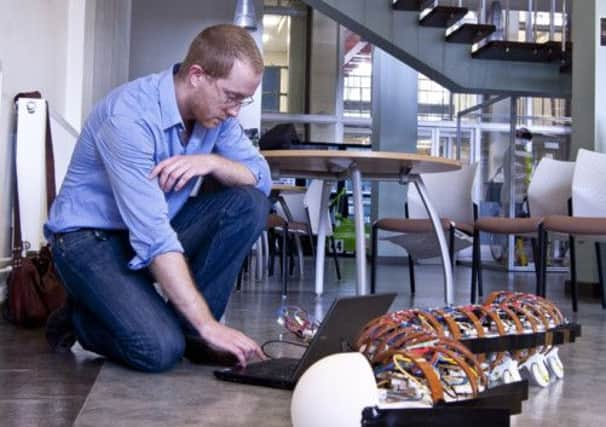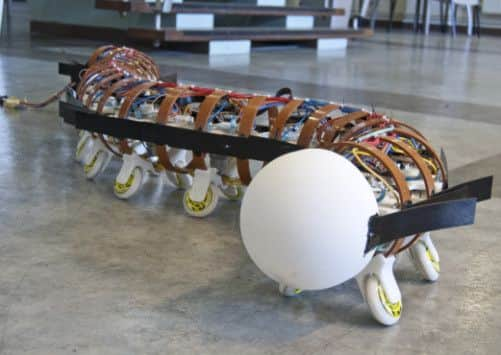Renaissance of the robots as city takes leap into the future


Back in the 1980s when it seemed we were on the edge of a brave, new and remote-controlled world, it was a rare episode of Tomorrow’s World which didn’t include the unveiling of a new robot.
We were promised an end to household chores, cars which would drive themselves and while writers had been fascinated for decades by the idea of a machine built by man which had the ability to act and think independently of its human creators, it finally looked like fiction could become reality.
Advertisement
Hide AdAdvertisement
Hide AdAnd then... nothing. Or at least that’s the way it seemed. While technology gathered pace, it all seemed geared towards making computers and mobile phones slimmer and faster. More than 30 years after Fiat launched its 1979 Strada model with the tagline “Handbuilt by Robots” we were still doing our own vacuuming.


However, it now seems the robotic age is not only alive and well, but it has found a major hub in Yorkshire. Leeds University has been chosen as the home for a new £4.3m national robotics centre, although the reality of the research which will be conducted there is unlikely to satisfy those who grew up dreaming of owning their own robotic companion.
“It’s very different to the science fiction perception of robots as thinking machines that can be creative or that are rational. It’s more that they can just act by themselves – but they’re pretty stupid in many senses,” says Dr Robert Richardson, head of the university’s new robotics facility.
“Making robots that look like humans is actually quite rare. The tasks you want a robot to do can be done with something much smaller and cheaper than trying to make it look human.
Advertisement
Hide AdAdvertisement
Hide Ad“If you want a robot to do the washing up, you don’t design something that looks human, you use a dishwasher.”
The development of robots has been relatively slow when compared with other technologies. Functions that most people take for granted, such as recognising faces and voices, are still far from perfect in robots.
“Robotics is just coming into its own, and I think it’s going to impact on all our lives,” says Dr Richardson. “With computers getting smaller and faster, robots can do things like visually perceive much easier than they could before.
“The key is the ability to integrate hard and soft mechanical structures with electric systems and computing in incredibly compact and complex ways. The human body is built from rigid bones, soft tissue, muscles, sensory organs and communications pathways, all squeezed into the smallest possible space. We hope to be able to use this inspiration to build robots with ever more integrated parts and increased capabilities.”
Advertisement
Hide AdAdvertisement
Hide AdThe new facility will be the national centre for robotic research, and will put Leeds on the map as the world leader in the field of robotics.
“It gives Leeds a national strength, and we hope that companies will open up locally in order to work with us. Working locally will be much better for them,” says Dr Richardson.
The facility brings together the expertise of departments across the university, including mechanical and electronic engineering, computer science and medicine. The main focus will be on three key areas – the development of robots for use in surgical procedures, improvements in prosthetics and designing what’s known as exploration robots which can access confined spaces such as collapsed buildings to help locate those who are trapped without putting those searching for them at risk.
In 2011, Dr Richardson used a robot to explore hidden passages in the Great Pyramid of Giza, Egypt.
Advertisement
Hide AdAdvertisement
Hide Ad“It was one of the most exciting things I’ve been involved with – getting to see inside the pyramid was amazing,” he says. “The challenge was that it was a very small confined space, and the robot couldn’t make a mistake.
“You’d think that the stone inside a pyramid would be quite strong, but it’s actually really soft, so there was a constant worry that you’d scrape the walls. The robot had to be quite gentle, and really reliable – that wasn’t easy.”
Over a three-hour period, the robot slowly crawled its way up a 200ft shaft which was too narrow for a person to climb.
“Once the robot went in, the shafts were so small there was no way of getting it out – so there was a lot of pressure,” says Dr Richardson. Along the shaft, the robot came across a small door which opened out into a secret room. The images recorded by the robot revealed a series of hieroglyphics which hadn’t been seen since the pyramid was originally built over 4,500 years ago.
Advertisement
Hide AdAdvertisement
Hide AdIt’s that kind of first hand experience which Dr Richardson hopes will give the new centre an edge on rival research facilities.
“Leeds already has a strong reputation for applied robotics. While most other institutions do a lot of theoretical work, we have a track record of building robots of what can be done physically.”
The team has already been working on a device with feet modelled on tree frogs which is designed to crawl inside patients’ bodies during abdominal surgery, allowing surgeons to see what they are doing on a real-time video feed.
Elsewhere, another research team is developing what’s known as “intelligent” prosthetics which anticipate an individual’s body movements.
Advertisement
Hide AdAdvertisement
Hide AdOf course, this doesn’t come cheap. However, the Engineering and Physical Sciences Research Council has agreed to invest £2.6m on new equipment at the Leeds centre, with the university providing at further £1.2m and industry contributing the final £500,000.
“It is wonderful news not only for the university’s research teams, but for Britain’s ability to compete internationally in robotics research,” adds Dr Richardson.
“It will bring together a suite of cutting edge technologies in one place that will be the envy of institutions across the world.”
The robotic renaissance doesn’t end at the university either. An organisation which calls itself Playful Leeds is running a year-long project called March of the Robots.
Advertisement
Hide AdAdvertisement
Hide AdLed by Emma Bearman it will include a range of creative activities and events across the city, with the intention of building a robot for Leeds next April.
“We want to find out from people what it should look and feel like, what it would do,” says Emma.
“All you have to do is scratch the surface and you find the pioneering medical robots that are being developed at the university – these amazing things are happening right under our noses
“It’s not just us going ‘aren’t robots great?’, there’s another side to it. The genie is out of the bottle in a lot of ways, and there’s definitely a dark side to it all.
Advertisement
Hide AdAdvertisement
Hide Ad“When you automate everything, it’s going to put people out of work. How do we feel about drones and robots being used in warfare?
“I suppose we need to ask ourselves where we want to be in this story. Do you want to be ahead of the robots or behind them?”
The March of the Robots was launched with an online campaign to fund a bid to bring a 1950s robot, Cygan, back to Leeds. It went up for auction at Christie’s on September 5.
“We were interested in Cygan because it’s a great talking point to get people thinking about robots and what that means to them,” says Emma.
Advertisement
Hide AdAdvertisement
Hide AdPlayful Leeds raised £7,179 from 117 separate pledges to try and buy Cygan for the city. Unfortunately the campaign to was unsuccessful with it fetching £17,500 at the auction. Instead the money will be used to build a robot for Leeds.
Playful Leeds may not have succeeded in buying Cygan, but the organisation has certainly got people talking about robots.
From fiction to fact – A history of robots
1920: The word robot is first used by the Czech author Karel Capeck, but it was his brother who really deserved credit for coining the term, which comes from the Czech word ‘robota’ meaning servitude.
1932: The first true robot toy is produced in Japan. The ‘Lilliput’ was a wind-up toy which walked. It was made from tin plate and stood just 15cm tall.
Advertisement
Hide AdAdvertisement
Hide Ad1941: Science fiction writer Isaac Asimov writes the short story Liar! in which he describes the Three Laws of Robotics. His stories later inspired the film I, Robot starring Will Smith.
1950: Alan Turing proposes a test to determine if a machine truly has the power to think for itself. To pass the test a machine must be indistinguishable from a human during conversation. It has become known as the “Turing Test”.
1961: The first ever industrial robot began work on the assembly line of car manufacturer General Motors.
1968: Stanley Kubrick makes Arthur C. Clarke’s, 2001: A Space Odyssey into a landmark film. Featuring HAL, the onboard computer that develops a mind of its own, it captured the public fears of the new robotic age.
Advertisement
Hide AdAdvertisement
Hide Ad1986: Honda launches a project to build a walking humanoid robot.
1997: The first Robocup tournament is held in Japan. The aim is to have a fully automated team of robots beat the world’s best soccer team by the year 2050.
2000: Honda debuts ASIMO, the frighteningly human next generation in its series of humanoid robots.